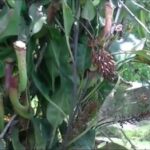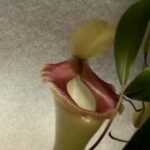As an Amazon Associate, this site earns commissions from qualifying purchases. For more details, click here.
The product of n. ampullaria and n. ventricosa x spectabilis, nepenthes Bloody Mary derives its name from its vivid red pitchers. It is one of the easier pitcher plants to grow especially if you live in a warm climate. There are some things you have to keep in mind though if you want to cultivate this plant.
This plant grows best in 60-85 F / 15.5-30 C with medium to high humidity. Nepenthes Bloody Mary requires poor soil and moderate watering. Like other tropical pitcher plants, Bloody Mary does not go dormant and must be kept indoors during winter.
Nepenthes Bloody Mary Care Sheet
| Soil | 1:1 perlite and peat or equal parts vermiculite, silica sand and peat |
| Water | Spring, distilled, purified, rainwater |
| Light | Full, indirect light |
| Food | Small insects, dried mealworms, fish flakes |
| Temperature | 60-85 F (15.5-30 C) |
| Humidity | 50% or higher |
| Dormancy | No |
| Propagation | Cuttings |
Soil
N. Bloody Mary shares many traits with its parents including the need for low nutrient soil. A 50/50 combination of peat and perlite is suitable. You can also try equal parts vermiculite, perlite and some silica sand.
N. Bloody Mary is not choosy when it comes to soil. Most nepenthes soil mixes will work with it so you should have no trouble finding compatible potting media. You can buy premixed soil or make one yourself. The most common materials are peat, vermiculite, silica sand and perlite. The Natural Sphagnum Peat Moss is also going to work with n. Bloody Mary.
Some growers prefer one over the other. With experience and experimentation you will find out which works best for your plant. If you are a beginner, the best option is to go with peat and perlite or a ready made mix.
Pot Container
A 5 inch pot is required for nepenthes Bloody Mary. Their leaves however, can grow up to 7 inches in diameter. The really large variants can span 19.5 inches / 50 cm and reach a height of 3.3 feet / 1 meter.
Unless you have one of these giant species, a 5 inch container will do. A 3 inch pot is too small and that is more suitable to something like nepenthes attenboroughii.
N. Bloody Mary should be on a sunny window or a greenhouse. These pitcher plants thrive in warm weather and medium to high humidity. You can also hang these pitcher plants outdoors if the location is warm enough.
Some n. Bloody Mary variants grow quickly so keep an eye on its container. Repot as soon as possible and do not wait for the roots to seep out of the pot hole.
If you are going to repot, use fresh new soil. You can use the same type of materials as before especially if the plant responds well to it. Water your nepenthes immediately after repotting to help it recover from the shock of an environment change.
Water
Nepenthes Bloody Mary requires moderate overhead watering. Use purified water to keep the soil constantly moist. Do not fill its pitchers with water and do not use the tray method unless it is really hot.
All nepenthes prefer natural, clean water. Distilled, purified or spring water are the most commonly used. You can also try reverse osmosis or rainwater but do not use water from the faucet.
Once you have decided what type, water from the top as you would any houseplant. Spray the water as evenly as possible until the soil is moist. Do not water so much the sol gets too damp. Once the soil has moistened, that is enough. Repeat when the media starts to dry.
While some like to use the tray method, top watering is usually enough for n. Bloody Mary. If it gets really hot – consistently 90 degrees and higher – you may sit the plant in a small amount of water. But if the climate is just fairly warm, overhead watering will do.
Light
Light is one of the most important areas when it comes to n. Bloody Mary care. You have to balance its need for light without overexposing.
If your nepenthes is outdoors, look for a sunny location but not directly under sunlight. If necessary, position the plant so that it is partially covered. In mild weather you can leave n. Bloody Mary in full morning light, but provide cover around noon. This applies to nepenthes alata too.
Bright, indirect light is the best for nepenthes Bloody Mary. It can tolerate full light but for the best results, do not place the plant directly under the sun.
If your nepenthes is indoors, a sunny window is the best. You should be able to tell if the plant gets too much or too little light. Reposition the pot as necessary to ensure it gets enough light. Do the same if your nepenthes is in a greenhouse. You can also use artificial lights such as the Spider Farmer Grow Lights to provide nourishment.
Temperature
Nepenthes Bloody Mary prefers 60-85 F / 15.5-30 C, but it should be fine in varying degrees of heat and cold. As long as it is not freezing or over 100 degrees, your plant will be all right.
Its adaptability stems from its parents. N. ventricosa x spectabilis grows in zones 6 to 12, while n. ampullaria thrives in zones 8 to 11. N. Bloody Mary inherited the best from both in terms of temperature tolerance.
Its parents prefer warm tropical climate so it is no surprise that n. Bloody Mary does too. However, the plant has a wider tolerance for temperature swings.
If the temperature is not exactly 60-85 F, It should not be a cause for concern. Growth might slow if it is too hot or cold but the plant will survive.
If the other variables – soil, light, water, humidity, nutrition –are ideal, your nepenthes Bloody Mary will be all right. If you are growing the plant in a greenhouse, make sure there is sufficient ventilation and it does not get too hot.
Humidity
Nepenthes Bloody Mary thrives in medium to high humidity. Ideally it should be 50% minimum, but the higher the better. Just like temperature though, this pitcher plant will continue to grow even in low humidity.
If the weather is in the 60-80 degree range, humidity is likely medium or high. You can leave the plant outside and you should not expect any issues. If it is dry and in the mid to high 90s you may need a humidifier to cool things down.
Increasing humidity also helps nepenthes produce liquids for its traps. This is one of the first things you should do if the leaves are drying up.
Nutrition and Feeding
Live and dead insects, flying and crawling bugs make up the bulk of a nepenthes diet. N. Bloody Mary also eats fish beta pellets, fish flakes and dried mealworms.
Sometimes a large animal might accidentally fall into the pitcher. It could die and rot there, causing the plant to smell bad. This is rare but it can happen. There are many other reasons why your pitcher plant may smell bad so maintenance is necessary.
For the most part though n. Bloody Mary only eats small insects. You probably do not even need to provide nutrition. If the plant is outside, its pitchers probably draw a lot of bugs already.
Nutrition is important, but pitcher plants can produce their own food via photosynthesis. These nutrients are additional supplements which speed up growth and improve health. So if nepenthes is indoors without any means of catching bugs, provide some freeze dried mealworms for it.
Dormancy
Nepenthes Bloody Mary does not go through dormancy. It cannot survive winter so you have to protect it from frost.
If you live in a tropical climate or the temperature is mostly around 60-85 F year around, leave the plant outdoors. If it rarely reaches 80 even in summer, grow n. Bloody Mary indoors.
If you have warm summers and cold freezing winters, you can cultivate the plant outdoors during spring and summer. When fall arrives, keep watch on the temperature. Bring the plant inside once it drops below 60 degrees.
If you have fluctuating weather, it is better to raise nepenthes Bloody Mary indoors. It saves you the trouble of moving the plant back and forth as the seasons change. Regardless where you decide to grow it, there has to be enough light and heat to keep the plant warm.

My fascination with carnivorous plants began many, many years ago with Venus Fly Traps. Now I am more than happy to impart what I know with other enthusiasts and those who are curious about meat eating plants.



